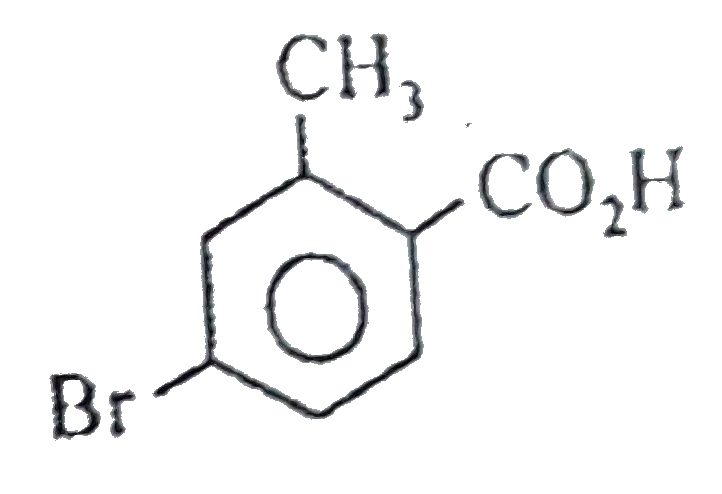α-Toluic acid in reaction withBr2+Fe gives




The correct Answer is:C
To solve the problem of what product is formed when α-Toluic acid reacts with Br₂ and Fe, we can follow these steps:
Step 1: Identify the structure of α-Toluic acid
α-Toluic acid is a benzene ring with a methyl group (–CH₃) and a carboxylic acid group (–COOH) attached to it. The methyl group is ortho- and para-directing, while the carboxylic acid group is meta-directing.
Step 2: Understand the reaction conditions
The reaction involves bromination using Br₂ in the presence of Fe. In this reaction, Br₂ will generate a bromonium ion (Br⁺), which acts as the electrophile.
Step 3: Determine the directing effects of the substituents
- The methyl group (–CH₃) is an electron-donating group and directs electrophilic substitution to the ortho and para positions.
- The carboxylic acid group (–COOH) is an electron-withdrawing group and directs electrophilic substitution to the meta position.
Step 4: Identify the possible positions for bromination
Considering the directing effects:
- The methyl group can direct bromination to the ortho and para positions.
- The carboxylic acid group can direct bromination to the meta position.
Step 5: Analyze the positions
When considering both groups, the only position that satisfies both directing effects is the position that is meta to the carboxylic acid group and ortho to the methyl group. This is because the methyl group prefers ortho and para, but the presence of the carboxylic acid group limits the bromination to the meta position relative to itself.
Step 6: Draw the product
The product will have the bromine atom attached to the carbon that is meta to the carboxylic acid group and ortho to the methyl group. The structure can be represented as follows:
- The benzene ring will have:
- A methyl group (–CH₃) at one position.
- A carboxylic acid group (–COOH) at another position.
- A bromine atom (–Br) at the meta position relative to the carboxylic acid group.
Step 7: Conclusion
The final product of the reaction is 3-bromo-α-toluic acid, where the bromine is attached to the carbon that is meta to the carboxylic acid group.
α-Toluic acid is a benzene ring with a methyl group (–CH₃) and a carboxylic acid group (–COOH) attached to it. The methyl group is ortho- and para-directing, while the carboxylic acid group is meta-directing.
The reaction involves bromination using Br₂ in the presence of Fe. In this reaction, Br₂ will generate a bromonium ion (Br⁺), which acts as the electrophile.
- The methyl group (–CH₃) is an electron-donating group and directs electrophilic substitution to the ortho and para positions.
- The carboxylic acid group (–COOH) is an electron-withdrawing group and directs electrophilic substitution to the meta position.
Considering the directing effects:
- The methyl group can direct bromination to the ortho and para positions.
- The carboxylic acid group can direct bromination to the meta position.
When considering both groups, the only position that satisfies both directing effects is the position that is meta to the carboxylic acid group and ortho to the methyl group. This is because the methyl group prefers ortho and para, but the presence of the carboxylic acid group limits the bromination to the meta position relative to itself.
The product will have the bromine atom attached to the carbon that is meta to the carboxylic acid group and ortho to the methyl group. The structure can be represented as follows:
- A methyl group (–CH₃) at one position.
- A carboxylic acid group (–COOH) at another position.
- A bromine atom (–Br) at the meta position relative to the carboxylic acid group.
The final product of the reaction is 3-bromo-α-toluic acid, where the bromine is attached to the carbon that is meta to the carboxylic acid group.
Similar Questions
Glucose on reaction with Br2 water gives
View SolutionCompound (A), C8H6NOBr, is optically active. Reduction of (A) gives (B) which reacts with nitrouos acid to form (C), dihydric alcohol. Benzene sulphonyl chloride reacts with (B) to give a product soluble in NaOH. Hydrolysis of (A) gives (D) which is an optically active acid. (A) does not give any precipitate with aqueous AgNO3 . Controlled oxidation of (A) gives monobromo benzoic acid. Compound (A) on reaction with Br2/Fe gives only one compound. Identify (A), (B), (C), and (D).
View SolutionAn organic compound A’ with molecular formula C7H7NO reacts with Br2/aqKOH to give compound B’, which upon reaction with NaNO2&HCl at O∘C gives C’. Compound C’ on heating with CH3CH2OH gives a hydrocarbon D’. Compound B’ on further reaction with Br2 water gives white precipitate of compound E’. Identify the compound A, B, C, D&E, also justify your answer by giving relevant chemical equations.
View SolutionAssertion: Bromobenzene upon reaction with Br2/Fe gives 1,4-dibromobenzene as the major product
Reason In bromobenzene the inductive effect of the bromo group is more dominant than the mesomeric effect in directing the incoming electrophile .
View SolutionBenzamide on treatment with Br2 and alkali gives
View SolutionAssertion : trans −2−Butene on reaction with Br2 gives meso−2,3−dibromobutane.
Reason : The reaction involves syn−addition of bromine.
View SolutionPropene on reaction with Br2inCCl4 yields
View SolutionCane sugar on reaction with nitric acid gives
View SolutionToluene, when treated with Br2Fe, gives o and p-bromotoluene, because the CH3 group-
View SolutionBenzoic acid is treated with SOCl2 and the product (X) formed is reacted with ammonia to give (Y). (Y) on reaction with Br2 and KOH gives (Z). (Z) in the reaction is
View Solution
